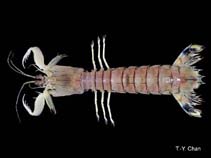Oratosquilla fabricii (Holthuis, 1941)
| Native range | All suitable habitat | Point map | Year 2050 |

|
| This map was computer-generated and has not yet been reviewed. |
| Oratosquilla fabricii AquaMaps Data sources: GBIF OBIS |
Classification / Names Common names | Synonyms | CoL | ITIS | WoRMS
Malacostraca | Stomatopoda | Squillidae
Environment: milieu / climate zone / depth range / distribution range Ecology
Benthic; depth range 0 - 130 m (Ref. 96667). Tropical
Distribution Countries | FAO areas | Ecosystems | Occurrences | Introductions
Indo-Pacific.
Length at first maturity / Size / Weight / Age
Maturity: Lm ? range ? - ? cm Max length : 17.5 cm TL male/unsexed; (Ref. 3590)
Maximum size is that of the junior synonym, Squilla calumnia (Ref. 3590).
Life cycle and mating behavior Maturity | Reproduction | Spawning | Eggs | Fecundity | Larvae
Some members of the order Stomatopoda pair for life and some come together only to mate. Males produce sperm ducts rather than spermatophores; females can brood a maximum of 50,000 eggs. Life cycle: Eggs hatch to a planktonic zoea which lasts for 3 months.
Main reference
References | Coordinator | Collaborators
Ahyong, S.T. 2002. (Ref. 3509)
IUCN Red List Status
(Ref. 130435: Version 2024-2)
CITES status (Ref. 108899)
Not Evaluated
CMS (Ref. 116361)
Not Evaluated
Threat to humans
Harmless
Human uses
| FishSource |
Tools
More information
Trophic Ecology
Food items
Diet composition
Food consumption
Food rations
Predators
Diet composition
Food consumption
Food rations
Predators
Ecology
Population dynamics
Growth
Max. ages / sizes
Length-weight rel.
Length-length rel.
Length-frequencies
Mass conversion
Recruitment
Abundance
Max. ages / sizes
Length-weight rel.
Length-length rel.
Length-frequencies
Mass conversion
Recruitment
Abundance
Life cycle
Distribution
Human Related
Aquaculture profiles
Stamps, coins, misc.
Stamps, coins, misc.
Outreach
Taxonomy
References
Internet sources
BHL | BOLD Systems | CISTI | DiscoverLife | FAO(Publication : search) | Fishipedia | GenBank (genome, nucleotide) | GloBI | Gomexsi | Google Books | Google Scholar | Google | PubMed | Tree of Life | Wikipedia (Go, Search) | Zoological Record
Estimates based on models
Preferred temperature
(Ref. 115969): 22 - 28.8, mean 27.3 (based on 692 cells).



